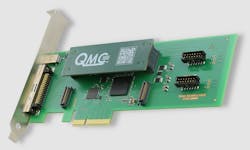Partner's Corner: What QMC (VITA 93) Means for Critical Embedded Systems
May 8, 2025 - Elma Electronic Inc, Fremont, CA
Mezzanine cards have long been used in embedded computing to enhance the performance of electronic devices to extend or change functionality, features or connectivity options within an existing system. For almost 20 years, XMC has served as the basis for many mezzanine card implementations.
VITA’s upcoming QMC (VITA 93) standard uses the same concepts as VITA 42, the pre-eminent XMC standard, to support high-speed, switched interconnect mezzanine cards, but it also provides enhanced performance in an exceptionally small form factor.
QMC is not only compact and able to handle high processing loads, but it also introduces a highly modular, flexible and scalable approach to I/O integration that enables users to mix and match I/O functions on a number of open standards platforms. Its broad applicability extends beyond aerospace and defense into several high-speed data environments found throughout the industrial, transportation, energy and manufacturing markets as well as in medical and scientific research.
So, we asked some of our QMC partners: How will QMC help system designers address today’s data processing requirements in rugged, deployed applications and why was it needed?
Contributor: Tim Tews, General Manager, TEWS Technologies GmbH
The new VITA 93 - QMC standard is an essential advancement for meeting today’s embedded system challenges, especially in rugged, deployed applications across the aerospace, defense, industrial, and transportation markets.
Contributor: Robert Greenfield, Business Development Manager, Acromag, Inc.
The rationale for the VITA 93 QMC mezzanine can be summarized in four words: smaller, faster, rugged, and standardized.
In defense and aerospace applications, the talk is often of requirements in terms of SWaP. The trend towards unmanned vehicles (airborne, marine, and ground-based) has accelerated the need for smaller systems. Many of the I/O functions implemented on a PMC or XMC board can now fit on a single or double-size QMC module, with less than a quarter or half the footprint, and much lighter.
Contributor: Mark Littlefield, Director, Systems Products, Elma Electronic
For Elma, the primary driver for developing the QMC standard was to give VNX+ (VITA 90) a mezzanine I/O expansion capability comparable to what XMC gives OpenVPX. VNX+’s small size (about 30% the size of OpenVPX per slot - see Figure 3) was simply too small for XMC, so an alternative was needed, and QMC was born.
QMC provides the critical features of XMC, including a high-performance host-side connector paired with a similar I/O side connector (comparable to XMC’s P15 and P16 connectors, but supporting higher speed protocols) in a package sized to permit two modules to be installed in a basic 19mm VNX+ module (or one double-sized module, if you like).
To read the entire article, visit Elma Electronic Inc
